This post may include affiliate links. Read the disclosure policy here. Thanks for the support!

Red sauce pasta is a traditional Italian meal that has gained popularity all over the world. Many people love this pasta dish for its hearty and comforting flavors, which are created with a straightforward tomato sauce. Red sauce pasta is a great option whether you’re searching for a simple weeknight supper or a mouthwatering dish to amaze your visitors.
Although I don’t eat pasta that often, this red sauce pasta recipe always comes to my mind when quenching my pasta cravings!
…And the ingredients for red sauce pasta are easily accessible at any grocery market.
The fact that red sauce pasta can be prepared in huge quantities and is a cost-effective dinner is one of its many wonderful qualities. It’s simple to double or treble the recipe to feed a large group or to have leftovers for lunch the next day. You may prepare a large quantity of it and freeze it for later use also.
About The Dish
The roots of red sauce pasta can be traced back to Italy, where tomato-based sauces have long been a mainstay of the country’s cuisine. Although tomatoes were first brought from the Americas to Italy in the 16th century, it wasn’t until the 18th century that they started to be used frequently in Italian cuisine.
In a cookbook printed in Naples in 1790, a tomato-based pasta sauce recipe was first formally documented. The dish is called “maccheroni alla napoletana,” which included tomato, onion, and lard sauce. This sauce served as the forerunner of the red sauce utilized in pasta meals today.
Italian immigrants introduced their culinary traditions to America in the late 19th and early 20th centuries. They brought foods that soon gained popularity among Americans, like pizza and spaghetti with tomato sauce. Pasta with red sauce has become a mainstay of Italian-American cooking and is now available in eateries and homes across the country.
Here’s how to make red sauce pasta!
Utensils You’ll Need
- Deep Frying Pan: To cook the pasta.
- Strainer: To strain the pasta after boiling it in water.
- Big Tablespoon or Ladle: To saute and stir.
- Grinding Jar: To make tomato puree.
Ingredients Poured
Servings: 4
Prep Time: 10 mins
Cook Time: 20 mins
Pasta: For this dish, a variety of pasta varieties can be used. The traditional option is penne, but for a different texture, try spaghetti, rigatoni, or fusilli. I used macaroni pasta because that’s all the pasta I had in my kitchen.
Onions & Tomatoes: Onions add a nice flavor to the pasta (you can use any kind of onions you like), and the tangy flavor of tomatoes to a red sauce pasta is like wheels to a car.
Ginger-Garlic Paste: Alternatively, you can use 4-5 garlic cloves. I like to use ginger-garlic paste because you don’t have to chop the cloves and makes the cooking process faster.
Oregano & Red Chilly Flakes: They are the main component of adding flavor to the pasta. The pungent flavor of oregano and the slight hotness of chilly flakes makes this dish full of flavor.
Cheese (optional): I used mozzarella, but you can go for parmesan, pecorino romano, asiago, and even cheddar. Cheese helps bind the pasta together (literally) and makes it rich and adds a subtle flavor.
Ketchup: This adds a little bit of sweetness to the pasta and gives an extra nudge to the tanginess of tomatoes.
Salt & Pepper
How to Make Red Sauce Pasta
For boiling pasta:
1. Set the water to boil, season with salt to taste, and add 1 teaspoon of oil. Once the water is boiling vigorously, add the macaroni pasta and cook for 7-8 minutes or until al dente.
2. Once the pasta has been strained, add 2 teaspoons of oil, salt, and pepper powder to taste, toss to combine, and set aside until the pasta is ready.
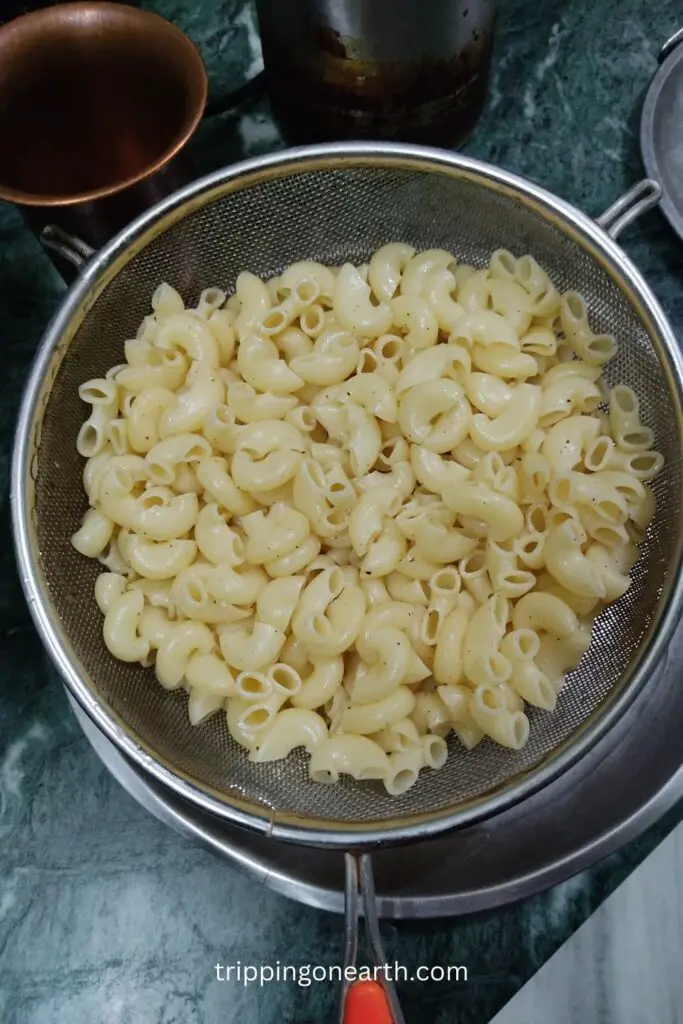
For red sauce pasta:
1. Thoroughly wash the tomatoes, cut them into quarters, then place them in a grinding jar and purée them.
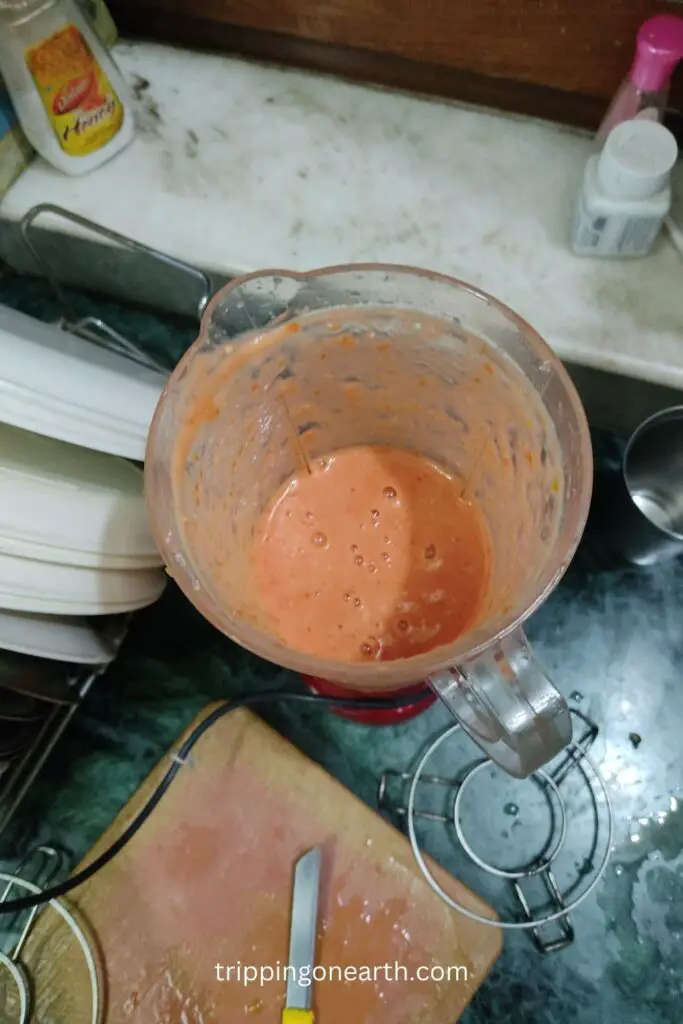
2. Place the pan on low heat, add the oil, and chopped onions and heat through over medium-low heat till they get translucent.
3. Add the ginger-garlic mixture and sauté for 30 seconds.
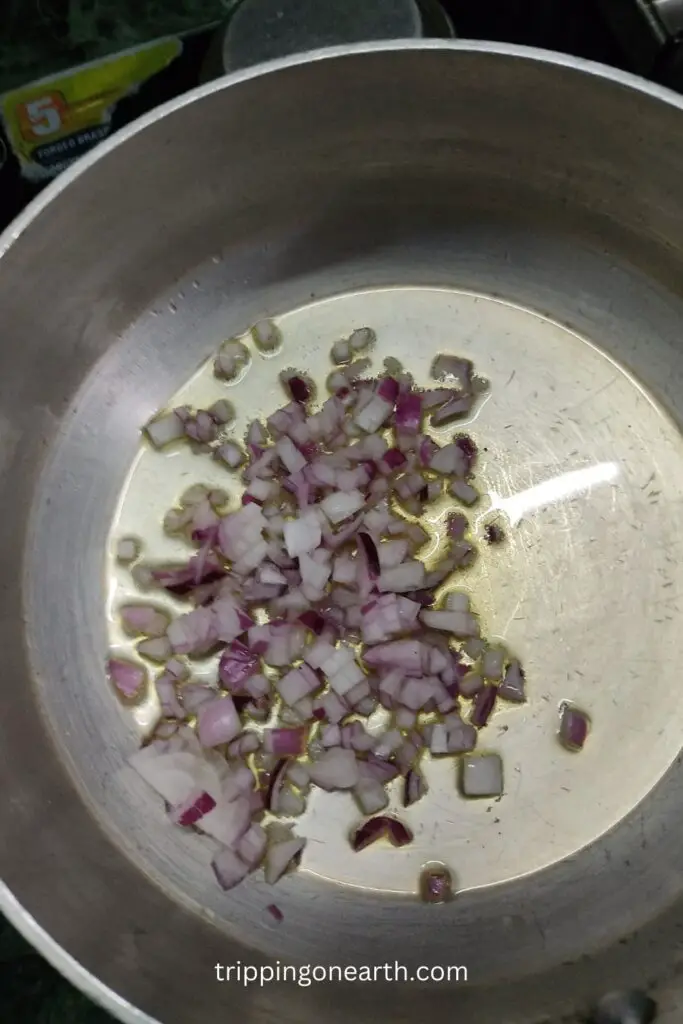
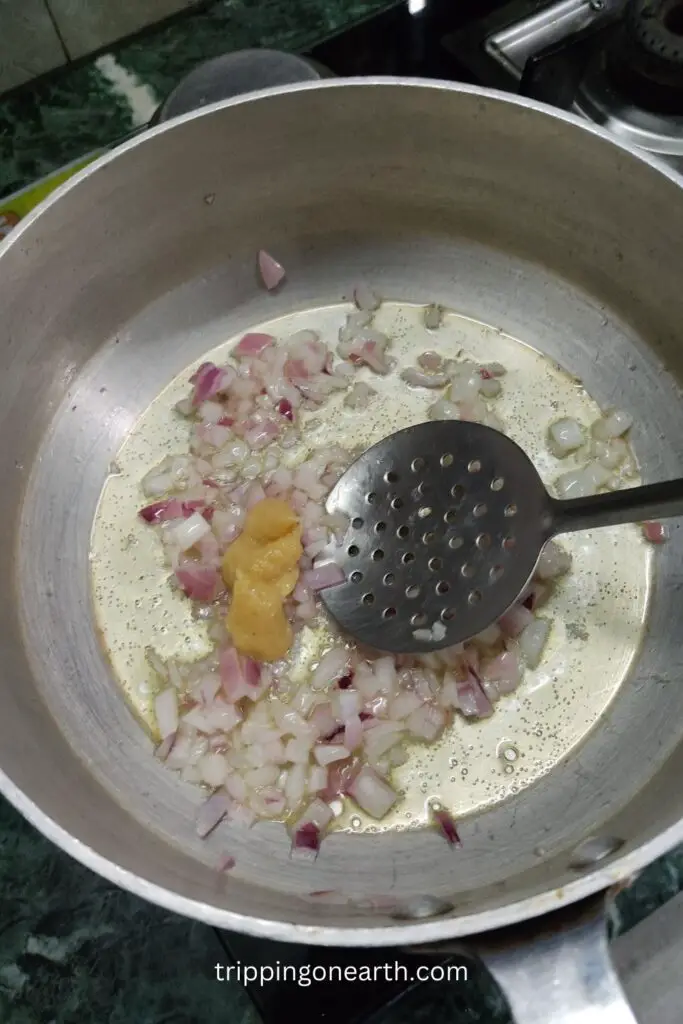
4. Now turn down the heat and add the Kashmiri red chilli powder. Cook for only a few seconds, maybe ten to fifteen.
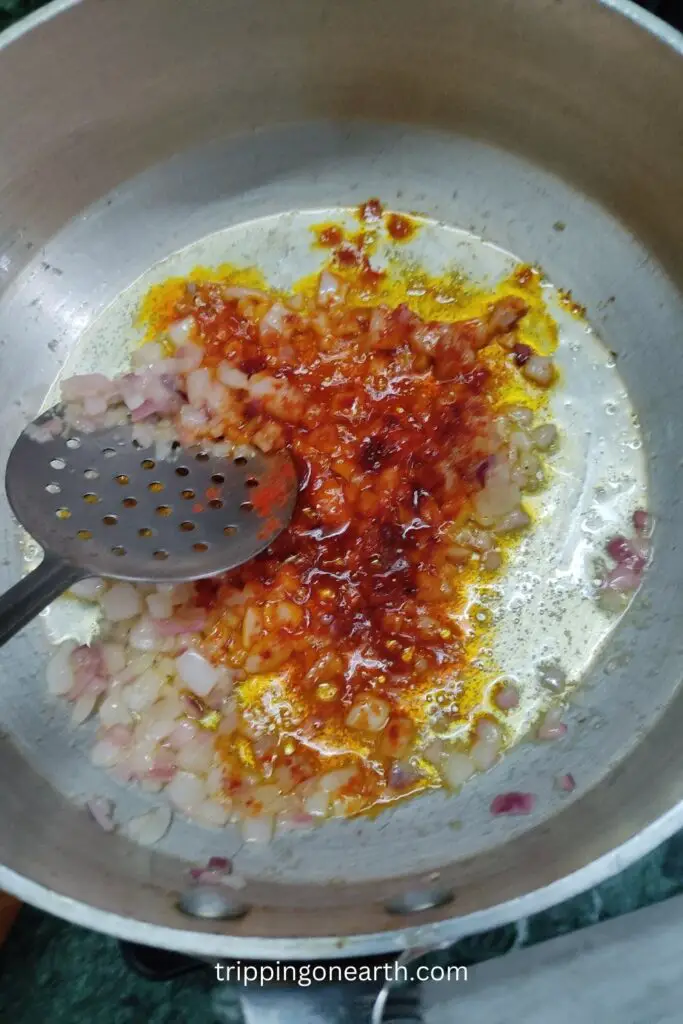
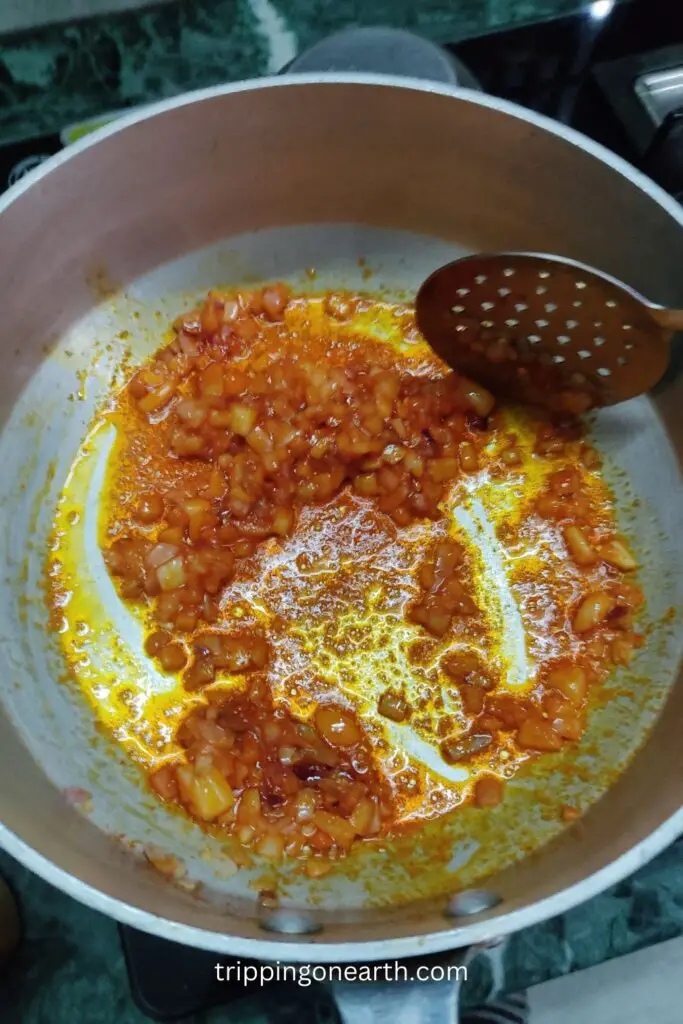
5. Now whisk in the tomato purée, salt to taste, and tomato ketchup. Cook for a further 1–2 minutes over medium-high heat before covering and cooking for a further 10 minutes.
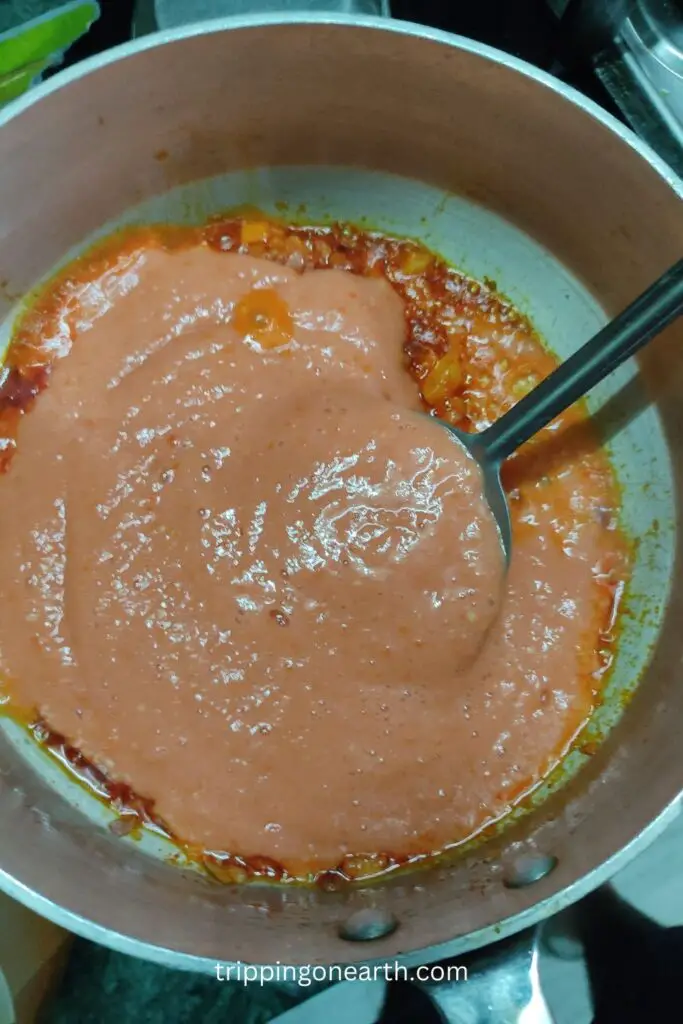
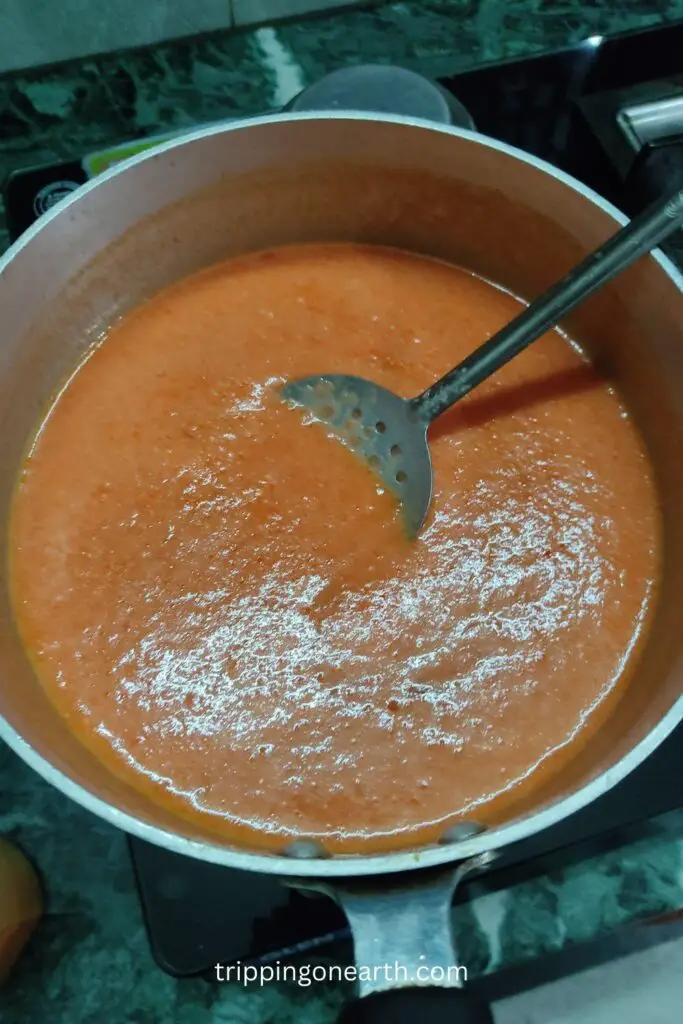
6. The homemade red sauce is now ready; set it away and use it later when preparing pasta for your family. Add oregano, red chilli flakes, and a dash of black pepper powder. Stir and heat for one minute.

7. To prepare pasta, just add the cooked pasta, mix gently, and simmer for 2-3 minutes on medium heat. If desired, top with processed cheese. Add little pasta water to the sauce to modify the consistency.


8. Your pasta is ready to serve.

Tips & Tricks
- You can also add meat such as ground beef or Italian sausage for a heartier dish.
- For people with dietary needs, gluten-free spaghetti is also an option, as is whole wheat pasta.
- Add a generous amount of cheese on top of the cooked pasta and cover it for 2 mins till it melts. This makes the dish more appealing.
- You can add vegetables like carrots, bell peppers, mushrooms, etc. to make the pasta more full.
Things to Keep in Mind
- Do not overcook the pasta as it will become mushy.
- If you are adding meat to your pasta, brown it beforehand in a pan before incorporating it into the sauce.
- Red sauce pasta is a versatile dish that can be customized to your liking. If you prefer a spicier sauce, add some red chilly flakes or cayenne pepper. If you like a creamier sauce, add some heavy cream or half-and-half to the skillet along with the tomato sauce.
Nutrition
Red sauce pasta’s nutritional value might change based on the particular components used in the recipe. However, the essential nutritional components of a typical serving of red sauce pasta are broken down as follows:
- Calories: A typical serving of red sauce pasta (1 cup of cooked pasta with sauce) contains around 300-400 calories, depending on the type of pasta and the amount of sauce used.
- Carbohydrates: Pasta is a carbohydrate-rich food, and a serving of red sauce pasta can contain anywhere from 30-60 grams of carbohydrates, depending on the type of pasta used. Whole-grain pasta will generally have more fiber and complex carbohydrates than refined pasta.
- Protein: Depending on the recipe, red sauce pasta can contain a moderate amount of protein, thanks to the addition of meat or cheese. A serving of red sauce pasta can contain anywhere from 10-20 grams of protein.
- Fat: The amount of fat in red sauce pasta will depend on the type of sauce used. A traditional tomato-based sauce will generally be low in fat, while a creamy Alfredo sauce will be higher in fat. A serving of red sauce pasta can contain anywhere from 5-15 grams of fat.
- Fiber: The fiber content of red sauce pasta will depend on the type of pasta used. Whole grain pasta will generally be higher in fiber than refined pasta, and adding vegetables to the sauce can also increase the fiber content.
- Vitamins and Minerals: Red sauce pasta can be a good source of certain vitamins and minerals, depending on the ingredients used. Tomatoes, which are a key ingredient in the sauce, are rich in vitamin C, potassium, and lycopene. Adding vegetables to the sauce can increase the vitamin and mineral content even further.
How To Store
Refrigerator: You may keep leftover red sauce pasta there for up to three days if you put it in an airtight container. Before storing the pasta, make sure to let it cool completely. Then, reheat it completely before serving.
Freezer: Red sauce pasta may be frozen if you need to keep it for more than three days. Pasta may be frozen for up to three months if it is put in an airtight container or freezer bag after it has cooled. When you’re ready to dine, let the pasta defrost overnight in the fridge, then give it a good stir-fry.
Separate the pasta and sauce: It is better to store the pasta and sauce separately if you plan to keep red sauce pasta for a long time. This will stop the sauce from being watery and the pasta from getting soggy. When you’re ready to serve, combine the pasta and sauce and store them separately in two containers.
FAQ
What types of pasta can I use for red sauce pasta?
You may use whatever kind of pasta you prefer, but some of the most well-liked options include fusilli, rigatoni, penne, and spaghetti.
Can I use canned tomato sauce for the red sauce?
Yes, canned tomato sauce is a good option. However, some people prefer to make their own sauce from fresh tomatoes or canned whole tomatoes that have been blended.
Can I use a different type of cheese instead of Parmesan?
You can use any cheese you choose, that much is true. Parmesan substitutes include Pecorino Romano, Asiago, and even cheddar.
How do I make the sauce less acidic?
You may adjust the acidity of tomato sauce by adding a sprinkle of sugar if it is too acidic for your taste.
Why I Love Red Sauce Pasta
- It is a very customizable dish and you can make it any way you like.
- The ingredients to make it are very less and are easily accessible.
- It is quick and easy to make and delicious.
Other Recipes That You’ll Love
- Chapati Pizza Recipe | How to Make the Best Chapati Pizza
- Paneer Bhurji (Easiest Paneer Recipe to Make!)
- Paneer Tikka Masala (Delicious and Easy to Make)
Please rate and comment if you make this red sauce pasta so I know how much you like it.
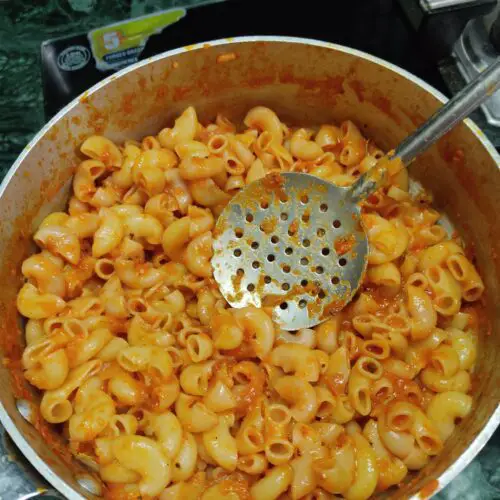
Red Sauce Pasta
Equipment
- 1 Deep frying pan
- 1 Strainer
- Grinding jar
- 1 Tablespoon/Ladle
Ingredients
For boiling pasta:
- 200 gms Macaroni pasta
- Water for boiling
- Salt to taste
- 1 pinch Black pepper powder
- 3 tsp Oil
Instructions
- Set the water to boil, season with salt to taste, and add 1 teaspoon of oil. Once the water is boiling vigorously, add the macaroni pasta and cook for 7-8 minutes or until al dente.
- Once the pasta has been strained, add 2 teaspoon of oil, salt, and pepper powder to taste, toss to combine, and set aside until the pasta is ready.
- Thoroughly wash the tomatoes, cut them into quarters, then place them in a grinding jar and purée them.
- Place the pan on low heat, add the oil, and sauté the ginger-garlic mixture for 30 seconds.
- Add the chopped onions and heat through over medium-low heat.
- Now turn down the heat and add the Kashmiri red chilli powder. Cook for only a few seconds, maybe ten to fifteen
- Now whisk in the tomato purée, salt to taste, and tomato ketchup. Cook for a further 1–2 minutes over medium-high heat before covering and cooking for a further 10 minutes.
- The homemade red sauce is now ready; set it away and use it later when preparing pasta for your family. Add oregano, red chilli flakes, and a dash of black pepper powder. Stir and heat for one minute.
- To prepare pasta, just add the cooked pasta, mix gently, and simmer for 2-3 minutes on medium heat. If desired, top with processed cheese. Add little pasta water to the sauce to modify the consistency.
Notes
- You can also add meat such as ground beef or Italian sausage for a heartier dish.
- For people with dietary needs, gluten-free spaghetti is also an option, as is whole wheat pasta.
- Add a generous amount of cheese on top of the cooked pasta and cover it for 2 mins till it melts. This makes the dish more appealing.
- You can add vegetables like carrots, bell peppers, mushrooms, etc. to make the pasta more full.
- Do not overcook the pasta as it will become mushy.
- If you are adding meat to your pasta, brown it beforehand in a pan before incorporating it into the sauce.
- Red sauce pasta is a versatile dish that can be customized to your liking. If you prefer a spicier sauce, add some red chilly flakes or cayenne pepper. If you like a creamier sauce, add some heavy cream or half-and-half to the skillet along with the tomato sauce.
- Refrigerator: You may keep leftover red sauce pasta there for up to three days if you put it in an airtight container. Before storing the pasta, make sure to let it cool completely. Then, reheat it completely before serving.
- Freezer: Red sauce pasta may be frozen if you need to keep it for more than three days. Pasta may be frozen for up to three months if it is put in an airtight container or freezer bag after it has cooled. When you’re ready to dine, let the pasta defrost overnight in the fridge, then give it a good stir-fry.
- Separate the pasta and sauce: It is better to store the pasta and sauce separately if you plan to keep red sauce pasta for a long time. This will stop the sauce from being watery and the pasta from getting soggy. When you’re ready to serve, combine the pasta and sauce and store them separately in two containers.
